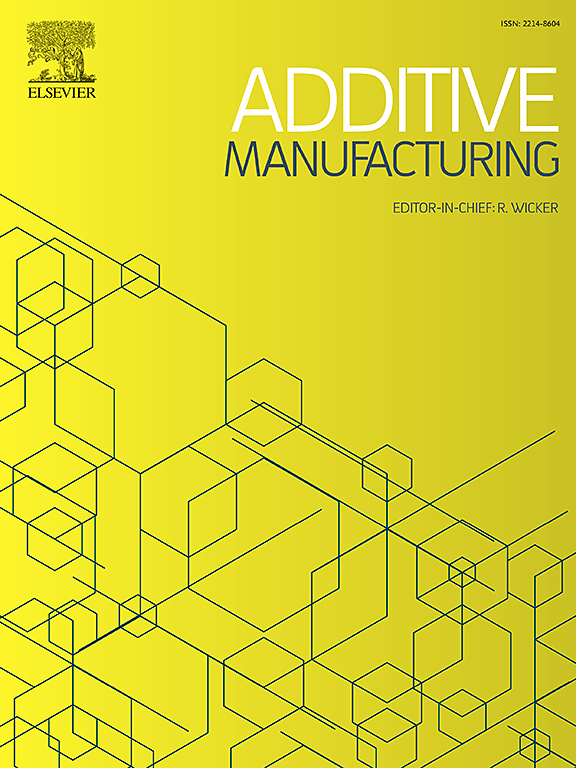Low Young’s modulus in laser powder bed fusion processed Ti–15Mo–5Zr–3Al alloys achieved by the control of crystallographic texture combined with the retention of low-stability bcc structure
IF 10.3
1区 工程技术
Q1 ENGINEERING, MANUFACTURING
引用次数: 0
Abstract
Metastable β (body-centered cubic)-phase Ti alloys, quenched from a high-temperature β-phase field, have attracted great interest as biomedical implants, owing to their low Young’s modulus. Recently, the application of additive manufacturing (AM) to β-phase Ti alloys has gathered much attention, because the AM process can form anisotropic crystallographic texture in which an elastically soft direction is preferentially oriented, resulting in low Young’s modulus in a specific direction. However, the effects of anisotropic texture and microstructure formed by the AM process on anisotropic elastic properties have not been clarified in detail. In the present study, we measured all the independent elastic stiffness components of β-phase Ti–15Mo–5Zr–3Al (mass%) alloys, prepared by bidirectional scanning with (XY-scan) and without (X-scan) an interlayer rotation of 90° in laser powder bed fusion (LPBF), one of the AM processes, using resonant ultrasound spectroscopy. The measurements revealed that the LPBF-processed Ti alloys exhibited strong elastic anisotropy and a low Young’s modulus (below 60 GPa) in the <100>-oriented direction of the alloy prepared by the XY-scan. Furthermore, micromechanics calculations based on Eshelby’s inclusion theory revealed that the single crystal constituting the alloys prepared by LPBF had almost the same elastic stiffness as that of a single crystal prepared by the floating zone melting, which indicated that the metastable β phase was retained by suppressing an easily occurring β- to ω-phase transformation during LPBF. These results indicate that texture control combined with retention of the metastable β phase by LPBF achieves biocompatible low Young’s modulus.
亚稳态β(体心立方)相钛合金由于具有较低的杨氏模量,在高温β相场中淬火后作为生物医学植入物引起了人们的极大兴趣。近年来,增材制造技术在β相钛合金中的应用受到了广泛的关注,因为增材制造工艺可以形成各向异性的晶体织构,其中弹性软方向优先取向,导致特定方向的低杨氏模量。然而,AM工艺形成的各向异性织构和微观结构对各向异性弹性性能的影响尚未得到详细的阐明。在本研究中,我们用共振超声光谱法测量了AM工艺中激光粉末床熔合(LPBF)层间旋转90°的双向扫描(x扫描)和不扫描(x扫描)制备的β相Ti-15Mo-5Zr-3Al(质量%)合金的所有独立弹性刚度分量。测量结果表明,lpbf处理的钛合金在x -扫描制备的合金的<;100>;取向方向上具有较强的弹性各向异性和较低的杨氏模量(低于60 GPa)。此外,基于Eshelby夹杂理论的微观力学计算表明,LPBF制备的合金单晶与浮区熔炼制备的合金单晶具有几乎相同的弹性刚度,这表明通过抑制LPBF过程中容易发生的β-到ω相变,保留了亚稳态β相。这些结果表明,LPBF结合亚稳β相保留的织构控制实现了生物相容性低杨氏模量。
本文章由计算机程序翻译,如有差异,请以英文原文为准。
求助全文
约1分钟内获得全文
求助全文
来源期刊

Additive manufacturing
Materials Science-General Materials Science
CiteScore
19.80
自引率
12.70%
发文量
648
审稿时长
35 days
期刊介绍:
Additive Manufacturing stands as a peer-reviewed journal dedicated to delivering high-quality research papers and reviews in the field of additive manufacturing, serving both academia and industry leaders. The journal's objective is to recognize the innovative essence of additive manufacturing and its diverse applications, providing a comprehensive overview of current developments and future prospects.
The transformative potential of additive manufacturing technologies in product design and manufacturing is poised to disrupt traditional approaches. In response to this paradigm shift, a distinctive and comprehensive publication outlet was essential. Additive Manufacturing fulfills this need, offering a platform for engineers, materials scientists, and practitioners across academia and various industries to document and share innovations in these evolving technologies.
 求助内容:
求助内容: 应助结果提醒方式:
应助结果提醒方式:


